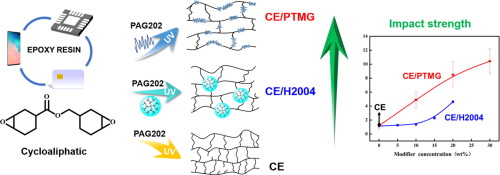当前位置:
X-MOL 学术
›
Eur. Polym. J.
›
论文详情
Our official English website, www.x-mol.net, welcomes your
feedback! (Note: you will need to create a separate account there.)
Toughness modification of cationic UV-cured cycloaliphatic epoxy resin by hydroxyl polymers with different structures
European Polymer Journal ( IF 5.8 ) Pub Date : 2020-03-01 , DOI: 10.1016/j.eurpolymj.2020.109594 Yuzheng Xia , Dong Zhang , Zhen Li , Heng Lin , Xiaonong Chen , Susan Oliver , Shuxian Shi , Lei Lei
European Polymer Journal ( IF 5.8 ) Pub Date : 2020-03-01 , DOI: 10.1016/j.eurpolymj.2020.109594 Yuzheng Xia , Dong Zhang , Zhen Li , Heng Lin , Xiaonong Chen , Susan Oliver , Shuxian Shi , Lei Lei

|
Abstract In this work, cationic UV-curable epoxy-expansive matrix composites based on cycloaliphatic epoxy resin (CE) were prepared using trarysulfonium hexafluorophosphate salt as photoinitiator, and hyperbranched polyester terminated with 6 hydroxy groups (H2004) or linear hydroxy-ended polytetramethylene ether glycol (PTMG) as toughness modifiers. Effects of H2004 and PTMG on the UV-curing kinetics, mechanical and thermal properties were systematically compared. An acceleration phenomenon was observed by real-time FTIR characterisation during the UV-curing of CE/H2004, which may be attributed to the hydroxy group participation of H2004 based on an activated monomer mechanism. However, the epoxy group conversion in the CE/PTMG composite decreased during UV irradiation owing to the random coil morphology of PTMG. Thermal-mechanical properties of the CE/H2004 composite were investigated by dynamic mechanical thermal analysis, which revealed that the glass transition temperature (Tg) decreased slightly as the H2004 dosage increased, in contrast to the Tg of the CE/PTMG composite, which increased as the PTMG content rose. Compared with CE, the thermal stability of CE/H2004 and CE/PTMG was less, but toughness was improved dramatically by increasing the content of H2004 or PTMG. At concentrations of H2004 and PTMG of 20% and 30%, respectively, the impact strength was improved from 1.14 J/cm2 for CE to 4.62 J/cm2 for CE/H2004 and 10.44 J/cm2 for CE/PTMG. This was further elucidated by fracture surface analysis with a scanning electron microscope.
中文翻译:

不同结构羟基聚合物对阳离子紫外光固化环脂族环氧树脂的韧性改性
摘要 本工作以六氟磷酸三锍盐为光引发剂,以 6 个羟基封端的超支化聚酯 (H2004) 或线性羟基封端的聚四亚甲基醚二醇为基团,制备了基于环脂族环氧树脂 (CE) 的阳离子紫外光固化环氧膨胀基复合材料。 (PTMG) 作为韧性改性剂。系统地比较了 H2004 和 PTMG 对 UV 固化动力学、机械和热性能的影响。在 CE/H2004 的 UV 固化过程中,通过实时 FTIR 表征观察到加速现象,这可能归因于基于活化单体机制的 H2004 羟基参与。然而,由于 PTMG 的无规卷曲形态,在紫外线照射期间,CE/PTMG 复合材料中的环氧基转化率降低。通过动态机械热分析研究了 CE/H2004 复合材料的热机械性能,结果表明,随着 H2004 用量的增加,玻璃化转变温度 (Tg) 略有下降,而 CE/PTMG 复合材料的 Tg 增加了随着 PTMG 含量的增加。与CE相比,CE/H2004和CE/PTMG的热稳定性较差,但通过增加H2004或PTMG的含量,韧性得到显着提高。在 H2004 和 PTMG 的浓度分别为 20% 和 30% 时,冲击强度从 CE 的 1.14 J/cm2 提高到 CE/H2004 的 4.62 J/cm2 和 CE/PTMG 的 10.44 J/cm2。这通过使用扫描电子显微镜的断口分析进一步阐明。这表明玻璃化转变温度 (Tg) 随着 H2004 用量的增加而略有下降,而 CE/PTMG 复合材料的 Tg 则随着 PTMG 含量的增加而增加。与CE相比,CE/H2004和CE/PTMG的热稳定性较差,但通过增加H2004或PTMG的含量,韧性得到显着提高。在 H2004 和 PTMG 的浓度分别为 20% 和 30% 时,冲击强度从 CE 的 1.14 J/cm2 提高到 CE/H2004 的 4.62 J/cm2 和 CE/PTMG 的 10.44 J/cm2。这通过使用扫描电子显微镜的断口分析进一步阐明。这表明玻璃化转变温度 (Tg) 随着 H2004 用量的增加而略有下降,而 CE/PTMG 复合材料的 Tg 则随着 PTMG 含量的增加而增加。与CE相比,CE/H2004和CE/PTMG的热稳定性较差,但通过增加H2004或PTMG的含量,韧性得到显着提高。在 H2004 和 PTMG 的浓度分别为 20% 和 30% 时,冲击强度从 CE 的 1.14 J/cm2 提高到 CE/H2004 的 4.62 J/cm2 和 CE/PTMG 的 10.44 J/cm2。这通过使用扫描电子显微镜的断口分析进一步阐明。CE/H2004 和 CE/PTMG 的热稳定性较差,但通过增加 H2004 或 PTMG 的含量,韧性得到显着提高。在 H2004 和 PTMG 的浓度分别为 20% 和 30% 时,冲击强度从 CE 的 1.14 J/cm2 提高到 CE/H2004 的 4.62 J/cm2 和 CE/PTMG 的 10.44 J/cm2。这通过使用扫描电子显微镜的断口分析进一步阐明。CE/H2004 和 CE/PTMG 的热稳定性较差,但通过增加 H2004 或 PTMG 的含量,韧性得到显着提高。在 H2004 和 PTMG 的浓度分别为 20% 和 30% 时,冲击强度从 CE 的 1.14 J/cm2 提高到 CE/H2004 的 4.62 J/cm2 和 CE/PTMG 的 10.44 J/cm2。这通过使用扫描电子显微镜的断口分析进一步阐明。
更新日期:2020-03-01
中文翻译:

不同结构羟基聚合物对阳离子紫外光固化环脂族环氧树脂的韧性改性
摘要 本工作以六氟磷酸三锍盐为光引发剂,以 6 个羟基封端的超支化聚酯 (H2004) 或线性羟基封端的聚四亚甲基醚二醇为基团,制备了基于环脂族环氧树脂 (CE) 的阳离子紫外光固化环氧膨胀基复合材料。 (PTMG) 作为韧性改性剂。系统地比较了 H2004 和 PTMG 对 UV 固化动力学、机械和热性能的影响。在 CE/H2004 的 UV 固化过程中,通过实时 FTIR 表征观察到加速现象,这可能归因于基于活化单体机制的 H2004 羟基参与。然而,由于 PTMG 的无规卷曲形态,在紫外线照射期间,CE/PTMG 复合材料中的环氧基转化率降低。通过动态机械热分析研究了 CE/H2004 复合材料的热机械性能,结果表明,随着 H2004 用量的增加,玻璃化转变温度 (Tg) 略有下降,而 CE/PTMG 复合材料的 Tg 增加了随着 PTMG 含量的增加。与CE相比,CE/H2004和CE/PTMG的热稳定性较差,但通过增加H2004或PTMG的含量,韧性得到显着提高。在 H2004 和 PTMG 的浓度分别为 20% 和 30% 时,冲击强度从 CE 的 1.14 J/cm2 提高到 CE/H2004 的 4.62 J/cm2 和 CE/PTMG 的 10.44 J/cm2。这通过使用扫描电子显微镜的断口分析进一步阐明。这表明玻璃化转变温度 (Tg) 随着 H2004 用量的增加而略有下降,而 CE/PTMG 复合材料的 Tg 则随着 PTMG 含量的增加而增加。与CE相比,CE/H2004和CE/PTMG的热稳定性较差,但通过增加H2004或PTMG的含量,韧性得到显着提高。在 H2004 和 PTMG 的浓度分别为 20% 和 30% 时,冲击强度从 CE 的 1.14 J/cm2 提高到 CE/H2004 的 4.62 J/cm2 和 CE/PTMG 的 10.44 J/cm2。这通过使用扫描电子显微镜的断口分析进一步阐明。这表明玻璃化转变温度 (Tg) 随着 H2004 用量的增加而略有下降,而 CE/PTMG 复合材料的 Tg 则随着 PTMG 含量的增加而增加。与CE相比,CE/H2004和CE/PTMG的热稳定性较差,但通过增加H2004或PTMG的含量,韧性得到显着提高。在 H2004 和 PTMG 的浓度分别为 20% 和 30% 时,冲击强度从 CE 的 1.14 J/cm2 提高到 CE/H2004 的 4.62 J/cm2 和 CE/PTMG 的 10.44 J/cm2。这通过使用扫描电子显微镜的断口分析进一步阐明。CE/H2004 和 CE/PTMG 的热稳定性较差,但通过增加 H2004 或 PTMG 的含量,韧性得到显着提高。在 H2004 和 PTMG 的浓度分别为 20% 和 30% 时,冲击强度从 CE 的 1.14 J/cm2 提高到 CE/H2004 的 4.62 J/cm2 和 CE/PTMG 的 10.44 J/cm2。这通过使用扫描电子显微镜的断口分析进一步阐明。CE/H2004 和 CE/PTMG 的热稳定性较差,但通过增加 H2004 或 PTMG 的含量,韧性得到显着提高。在 H2004 和 PTMG 的浓度分别为 20% 和 30% 时,冲击强度从 CE 的 1.14 J/cm2 提高到 CE/H2004 的 4.62 J/cm2 和 CE/PTMG 的 10.44 J/cm2。这通过使用扫描电子显微镜的断口分析进一步阐明。











































 京公网安备 11010802027423号
京公网安备 11010802027423号